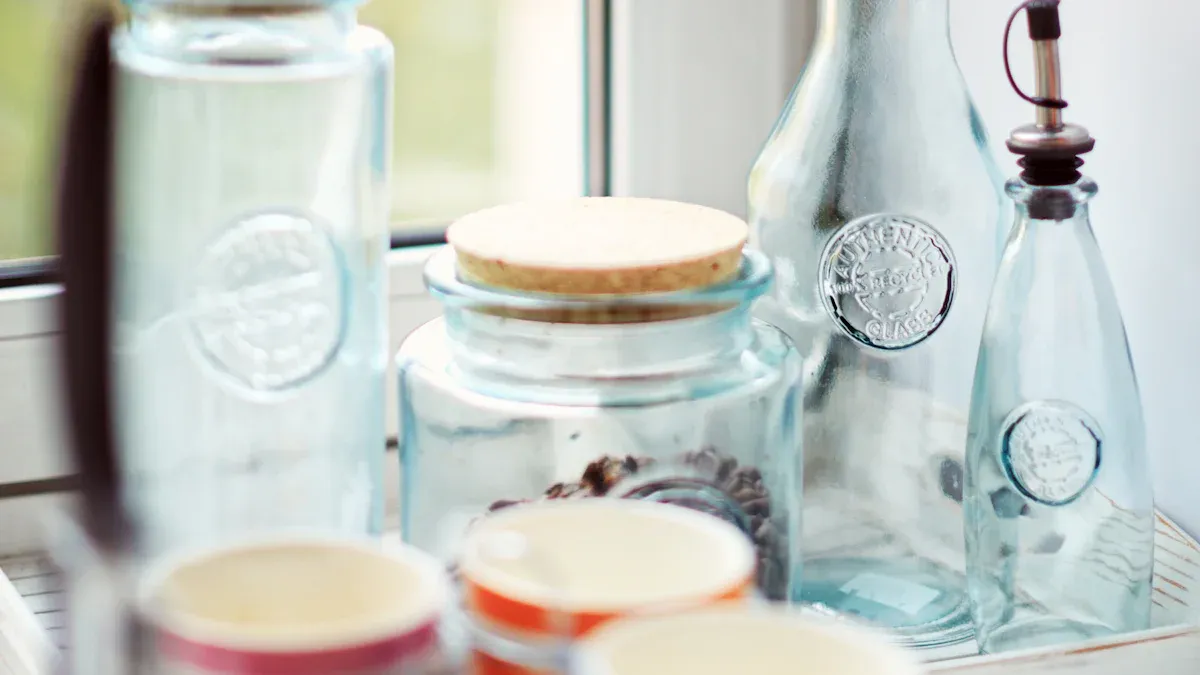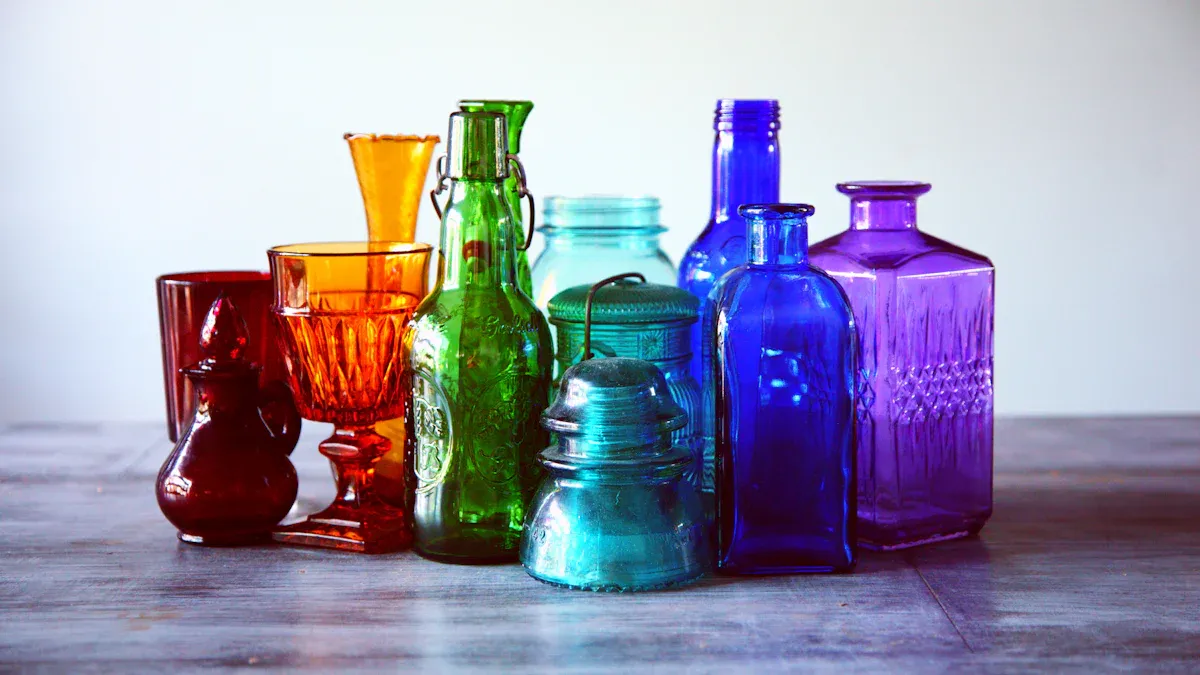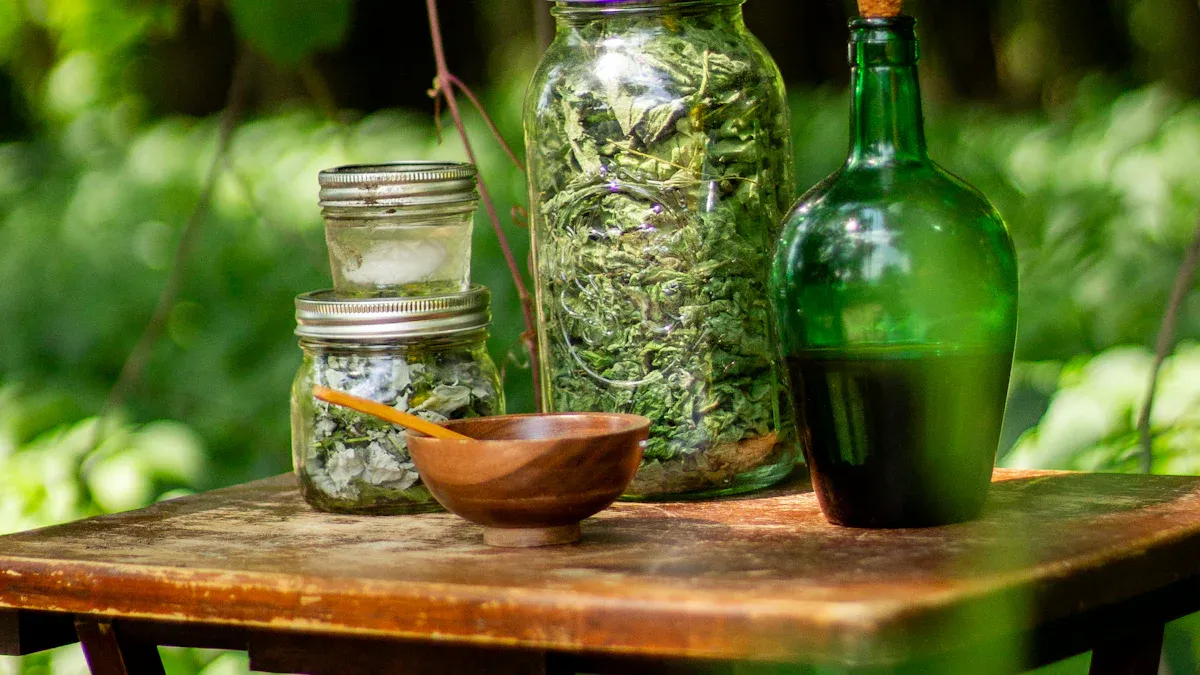What’s the Difference Between Bottles and Jars?

When picking bottles or jars, understanding the difference between bottles and jars is essential. Bottles have small necks, making them ideal for liquids like water or oil. In contrast, jars have wide openings, which makes them perfect for solids or thicker items like sauces or jams.
Knowing the difference between bottles and jars helps you choose the best container for your needs, whether for ease, storage, or use.
Their unique shapes are designed for specific tasks, aiding you in storing and keeping things organized.
Key Takeaways
- Bottles have small necks, good for pouring liquids like water or oil.
- Jars have wide openings, great for storing solids like sauces or jams.
- Use bottles for liquids and jars for solids for better storage.
- Think about the container material; glass and metal are better for the planet, but plastic is light and less eco-friendly.
- Knowing how bottles and jars differ helps you pick the right one for storing food.
Physical Characteristics

Shape and Design
The shape of a container shows what it’s used for. Bottles and jars look very different. Bottles are tall and slim with narrow necks, making them great for pouring liquids. Jars, however, are round with wide openings, which work better for holding solids or thick items.
Different bottle shapes have special uses:
- The Burgundy bottle has sloped shoulders and a pear-like body. It helps identify grape types.
- The Bordeaux bottle is shorter and sturdier, made for heavier red wines.
- Modern bottles come in various heights, usually between 330mm and 350mm. Colors like green, brown, and blue are chosen for looks and function.
Jars focus on being easy to use. Their wide tops let you scoop or pour easily. This makes them great for peanut butter, pickles, or sauces.
Size and Capacity
The size and capacity of bottles and jars are also different. Bottles are thinner and taller, saving space for liquids. They can hold a few ounces to several liters. For example, water bottles often come in 500mL or 1L sizes, while wine bottles usually hold 750mL.
Jars are wider and can hold more for their height. This makes them good for bulky or heavy items. A mason jar holds 16 ounces, but bigger ones can store up to a gallon. Their wide tops make it easy to fill them with chunky items like whole fruits or vegetables.
Opening and Neck Structure
The opening and neck design help tell bottles and jars apart. Bottles have narrow necks to control liquid flow. This is useful for drinks, oils, and other pourable things. The necks can be different:
- No-neck type: Found in wide-mouth bottles for food storage.
- Short-neck type: Seen in drink bottles, with straight or slightly curved necks.
- Long-neck type: Common in wine bottles, where the long neck adds style.
Jars, on the other hand, have no neck or a very short one. Their wide mouths connect directly to the body, making it easy to scoop or spoon out contents. This design is perfect for items like sauces or spreads.
| Type of Neck | Description | Characteristics |
|---|---|---|
| No-neck type | Wide-mouth version for food | Direct connection to shoulder line |
| Short-neck type | Common for beverages | Short neck with straight lines or curves |
| Long-neck type | Typically for wine | Longer neck that alters the overall shape |
| Shoulder types | Various shapes like sloping | Changes in length, angle, and curve |
These differences make it simple to tell if a container is a bottle or a jar. When shopping, look at these features to pick the right one for your needs.
Functionality and Uses
Common Uses for Bottles
Bottles are great for holding liquids. Their narrow necks make pouring and drinking simple. Water bottles are handy for staying hydrated when you’re out. Stainless steel bottles last longer and collect fewer germs than plastic ones. Cleaning bottles often helps keep them safe to use.
Here are some cool facts about storing liquids in bottles:
- Germs grow more in bottles over time.
- Stainless steel bottles have fewer germs than plastic ones.
- Sharing bottles by mouth can spread water-related illnesses.
A study tested 6,516 water samples from bottles. It found 5.6% had harmful substances. To reach risky levels of DEHP or BPA, you’d need to drink 231 liters or 124 liters of water daily, respectively.
| Statistic | Value | Description |
|---|---|---|
| Total values tested | 6,516 | Number of water samples analyzed |
| Positive tests | 5.6% | Percentage of samples with harmful substances |
| DEHP limit | 231 liters/day | Water needed to reach health risk threshold |
| BPA limit | 124 liters/day | Water needed to reach health risk threshold |
Bottles are also used for oils, juices, and fizzy drinks. Their design stops spills and keeps things fresh, making them very useful.
Common Uses for Jars
Jars work well for semi-solid or solid foods. Their wide tops make scooping and pouring easy. That’s why they’re used for peanut butter, jams, and sauces. In medicine, jars hold creams, ointments, and gels. These need packaging that keeps them clean and fresh.
More people are using jars because of the rise in skin care and medical products. In kitchens, jars store spices, pickles, and dry goods like flour or sugar. Their strong build and airtight lids keep food fresh and safe from moisture.
Are Bottles and Jars Interchangeable?
Bottles and jars have different uses, but sometimes they can switch roles. Wide-mouth bottles can hold semi-solid foods. Jars can store liquids like soup or broth. Still, their designs make them better for certain jobs. Bottles are best for pouring liquids. Jars are better for holding bulky items.
Pick the right container based on what you need. Use bottles for liquids and jars for solids or semi-solids. Knowing the difference helps you choose the best option every time.
Materials and Manufacturing
Materials Used for Bottles
Bottles are made from different materials, each with special features:
- Plastic: Types like PET and HDPE are very common. These plastics are light, strong, and recyclable. In 2018, PET and HDPE bottles were recycled at rates of 29.1% and 29.3%.
- Glass: Glass can be recycled endlessly without losing quality. It’s often used for drinks and high-end products.
- Aluminum: Aluminum is great for recycling, saving 95% of the energy needed to make new aluminum.
Each material has its own advantages. Plastic is cheap and flexible. Glass feels fancy and is easy to recycle. Aluminum is light and eco-friendly.
Materials Used for Jars
Jars are made from materials that match their purpose. Common materials include glass, plastic, and metal.
Glass jars are popular for food and drinks. They look nice and are recyclable, making them a green choice. Plastic jars are light and affordable, perfect for things like creams or powders. Metal jars are less common but protect items from light and air, which is important for cosmetics or special foods.
Each material helps jars work well for different needs.
Environmental Considerations
Think about the environment when picking bottles or jars. Glass bottles can be recycled but need more energy to make and move because they’re heavy. Plastic bottles are easier to produce but break down after being recycled a few times.
Recycled aluminum cans are one of the best choices. They’re light, easy to recycle, and use much less energy than glass or plastic. For drinks like milk or juice, Tetra-pak cartons often have a smaller environmental impact than bottles.
Knowing these facts can help you pick greener containers.
Practical Examples

Everyday Examples of Bottles
Bottles are everywhere in your daily life. You probably use them more often than you realize. Plastic water bottles are one of the most common examples. In the U.S., people purchase about 50 billion plastic water bottles every year. That’s roughly 13 bottles per person each month!
Other examples include bottles for beverages like soda, juice, or milk. Many households also rely on bottles for cleaning products such as dish soap or laundry detergent. Reusable bottles, made from stainless steel or glass, are becoming more popular. These are great for reducing waste and staying hydrated on the go.
Did you know? Americans use between 175 million and 500 million plastic straws daily, many of which come with bottled drinks.
Everyday Examples of Jars
Jars are just as common as bottles but serve different purposes. You’ll find them in your kitchen holding peanut butter, jams, or pickles. Mason jars are especially popular for storing homemade sauces, soups, or even salads. Their airtight lids keep food fresh and safe from moisture.
In addition to food, jars are widely used in cosmetics. Creams, lotions, and scrubs often come in small glass or plastic jars. You might also see jars in craft rooms, where they store buttons, beads, or other small items. Their wide openings make them perfect for scooping or pouring.
Tip: Reuse glass jars for organizing your pantry or storing leftovers. It’s an eco-friendly way to reduce waste!
How to Identify Bottles vs. Jars in Stores
When shopping, you can easily tell bottles and jars apart by their design. Bottles are taller and slimmer, with narrow necks. They’re usually found in the beverage aisle or cleaning supplies section. Look for items like soda, water, or oil.
Jars, on the other hand, are shorter and wider. Their wide mouths make them easy to spot in the food aisle. Check for products like pasta sauce, pickles, or peanut butter. If you’re unsure, remember this: bottles are for pouring, while jars are for scooping.
Pro Tip: Pay attention to the lid type. Bottles often have screw caps, while jars usually have twist-off or pop-top lids.
Knowing how bottles and jars differ helps you choose wisely. Bottles are great for liquids since their narrow necks help pour easily. Jars are better for solids or thick items because their wide tops make access simple. Each type is made for a specific use. By understanding these differences, you can pick the right one for food, drinks, or home storage.
Tip: Think about the material and its eco-friendliness before deciding.
FAQ
What makes bottles and jars different?
Bottles have small necks, perfect for holding liquids. Jars have wide tops, making them better for solids or thick foods. Their shapes decide how they are used.
Can bottles and jars be recycled?
Yes, both can be recycled. Glass and aluminum can be reused forever. Plastic can only be recycled a few times. Check your local rules for recycling.
Are jars better for storing food than bottles?
Jars are great for chunky foods like pickles or sauces. Their wide tops make scooping easy. Bottles are better for liquids like juice or oil.
Why do bottles have small necks?
Small necks help control how liquids pour out. This stops spills and keeps the liquid fresh by blocking air.
Can jars hold liquids?
Yes, jars can store liquids like soup or broth. But their wide tops make them easier to spill. Jars are better for keeping liquids at home, not for carrying them.
